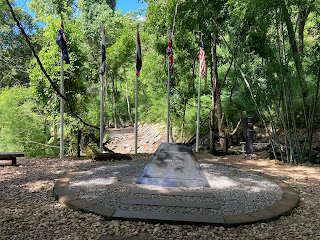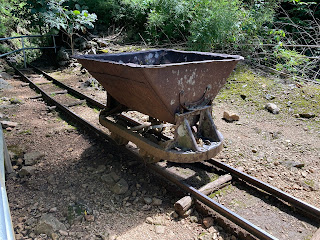October 21st, 2024
With no luck yesterday with travel agents, I spoke to the owner
of the Bamboo House. She was able to
arrange a private taxi to take me to Hellfire Pass, check out some waterfalls
and then drop me off in order to catch a train to make my way back to Kanchanaburi
and cross the infamous bridge over the River Kwai.
My female driver’s name was Ham and although she didn’t
speak much English (more than my Thai though), she was very courteous and
charming. After we stopped so I could
pick up some food for breakfast and lunch at a local coffee shop, we drove for
almost an hour and a half to reach the Hellfire Pass Interpretive Centre.
The Hellfire
Pass, also known by the Japanese as the Konyu Cutting, was a section of a
railway that the Imperial Japanese Army was try to construct to link Thailand
to Burma (known as Myanmar today). They
needed to support their forces in Burma as shipping lanes were under increasing
attacks by Allied submarines and aircraft in 1942. The railway would have to pass through more
than 400 kilometres of jungle, mountains and rivers. It would be no small task that was for sure.
The entrance to the memorial centre:
However, the Japanese tapped into a large labour force of POWs
(prisoners of war) that mainly consisted of English, Australian, Dutch and American
soldiers, starting with about 12,000 men.
Most materials for the railroad were locally sourced such as the wood
for bridges and railway ties.
Construction began in November 1942 and the plan was to complete it by
the following December. It was an ambitious
plan, but the Japanese had what was in effect an unlimited supply of slave
labour.
The initial hallway with names of many of the victims.
It was not just POWs but also Malays, Chinese and Tamils
from Malaya known as Romusha. These guys
had it even worse that the POWs as they had no leaders or organizational structure
to support them. About one third of the
Romushas died in the construction of the railway.
One of the survivors returned many years later and walked the line one more time.
The working conditions were horrific. It was not uncommon for the workers to slave
away for 16-18 hours a day with meagre rations of rice, the occasional tiny fish
that were more bones than meat and some diluted vegetable soup. Diseases such as cholera and malaria also
took their toll on the men.
The men were primarily using hand tools, such as an 8-pound
hammer and chisel, to pound into the solid limestone deep enough so that
explosives could be placed to blow out the rock which would then have to be
hauled away. They worked in teams of two,
with one main holding the chisel as the other pounded away. A slight slip of the hammer could crush a finger. A small cut could result in a tropical ulcer
which would devour flesh and could mean amputation of a limb. How anyone survived, I don’t know.
A photo of one of the thousands of Australian prisoners of war:
The Japanese soldiers were under duress from their superiors
to complete the railroad on schedule so there was a time known as the “Speedo”
period. Not knowing English, this was
the motivating word used by the Japanese soldiers to hurry the pace of work. “Speedo! Speedo! Speedo!”
Prisoners who didn’t keep up were subjected to beatings, some of which
were fatal. Many Australians suffered
during the Speedo period…and now the rest of the world has been subjected to
the Speedo by the Australians ever since…sorry, bad joke. But that was one thing that a few of the
interviewed Aussie soldiers mentioned. A
good sense of humour and having a solid mate (friend) were two of the things
that helped them get through the ordeal.
After visiting the memorial centre, it was time to walk a section
of the now non-existent railroad. The
prisoners worked into the night and so it was called Hellfire Pass because the
sight of emaciated prisoners labouring by burning torchlight resembled a scene
from hell. Visitors had the option of a
short walk, about 600 meters, or a longer jaunt that was 2.3 kilometres (one
way). Since I had Ham at my disposal, she
could pick me up at the end of the 2.3 km trail so I wouldn’t have to do the return
trip. There was an audio guide you could
use, which I did, and it was worthwhile.
Anyone hiking the longer trail also had to take a walkie talkie radio
with you so that the staff could check on you once in a while.
Looking at the viewpoint from outside:
Interesting how such beautiful scenery would have been hell to the POWs some 80 years ago.
Since trains can’t go up or down any serious grade, I figured the walk couldn’t be that bad although it was early afternoon and it was getting hot and humid, but I was prepared with lots of water, a hat and sunscreen. There was a bit of up and down where the wooden bridges used to stand but it was nothing major.
The first main section of “cutting” was the biggest
one. It was about 75 meters long and up
to 25 meters deep. Incredible to think
that this was carved out by starving men with primarily hammers and
chisels. They didn’t even have wheelbarrows
to carry the rock away. They had to
carry them out on makeshift-like stretchers made of bamboo poles. Speaking of bamboo, wow, they used it for
everything…from plates to carrying water to urinals to needles (yes, medical
needles) and a myriad of other uses.
A drillbit stuck in the rock:
Now it was on to the “longer” walk. I was a bit surprised that I only saw two
other tourists who decided to go the extra mile (which was probably about what
it was) as there were some gorgeous views of the surrounding mountains and
jungle.
A flutter of butterflies:
Here's what it looked like:
In the end, around 6300 British, 2800 Australian and 2500
Dutch soldiers lost their lives. So did
1000 Japanese soldiers…and who knows how many Romushas perished. No wonder it was known as the “Death Railway”.
The road on the drive out of the jungle:
After the hike, Ham suggested that we stop at the Sai Yok Noi
waterfalls as this is a popular tourist spot, mainly for Thais. I like the odd waterfall, but I must admit I’ve
become a bit jaded about them over the years.
They’re nice to look at for a few minutes, then it’s time to move
on. I was more concerned about catching
the Death Railway train and make sure that I got to cross the bridge over the
River Kwai.
The place was very busy but amazingly Ham found a parking spot
close to the falls. I told her that I
would likely only be about 5 minutes. Passing
by numerous food and souvenir vending stalls, I was pleasantly surprised at how
cool these falls were. Water was flowing
everywhere, around trees, under walkways and in some cases even down the stairs
that took you closer to the main waterfall.
The entrance to the waterfalls:
Kids were frolicking in the water with a few of them sliding
down a short, natural waterslide.
Families were spread out everywhere for a picnic, in one case on a small
island surrounded by water just big enough for their two blankets. The main waterfall was about 50-60 feet
high. I was impressed, but it was time
to move on.
The main set of falls:
Ham dropped me off at the Krasae railway station in order to
catch the train. Well it was more of a
platform than a station. I could have
caught the train at the start of the line, at a town called Nam Tok that we had
passed through, but then I would have missed the waterfalls. I assumed that Ham knew what she was
doing.
There were already about 30-40 other tourists patiently
waiting. I quickly checked out a small
cave with a Buddha statue inside (surprise, surprise). Some people were walking a short way down the
track, which was on a long, serpentine bridge that ran parallel to the curvy River
Kwai…seemed a bit dodgy knowing that the train was on its way.
For viewing purposes, I had read that it was best to be on
the left side of the train. I was a bit
dismayed when I alighted the train and it was already fairly full. I wandered to the next car and found an empty
seat on the left side, but facing backwards, with one woman occupying the seat
across from me. We pulled away from the
platform and the scenery from the raised bridge was great.
Looking back towards the platform.
Shortly after the bridge, we arrived at another platform and
I was surprised when a large majority of the tourists got off the train, including
the woman near me so at least I now had a seat facing forward. Had I missed something? Why are they getting off here? Well, it turned out that the rest of the trip
was away from the river, just passing through fields. It was still a nice trip but not what I was
expecting. Was there better scenery
before I got on the train? I had seen some
great pics online of trains passing over a bridge, like the one we had just
traversed. After a bit more research, I
think that was it. Huh.
One of the photos I saw online that got me excited about this train ride...but I guess you don't get that perspective when you're on the train!
I'm not sure what plant this was, but it was definitely a crop of some sort.
Passing by a nice temple.
About an hour later was the big event, crossing the Bridge
over the River Kwai. The bridge had a
lot of tourists hanging out on small side platforms, taking photos and videos of
the train as we passed by, while I was filming them. It was hard to say who was the main
attraction…the bridge or the train? I
guess it was the train on the bridge…
Crossing the River Kwai:
The train stopped just after the bridge and it was only then that I clued in that the day before when I arrived in Kanchanaburi, I didn’t even realize that the bridge was right there. Granted I had been in the back of the train so I was at least 150 meters from the bridge, but I still chuckled at myself.
I sat down for a well-deserved sunset beer by the bridge.
That was an educational and rewarding day.










































No comments:
Post a Comment